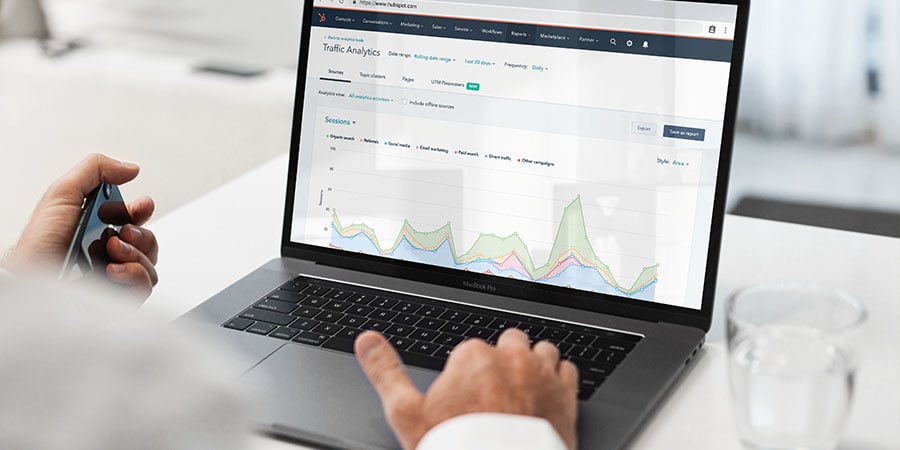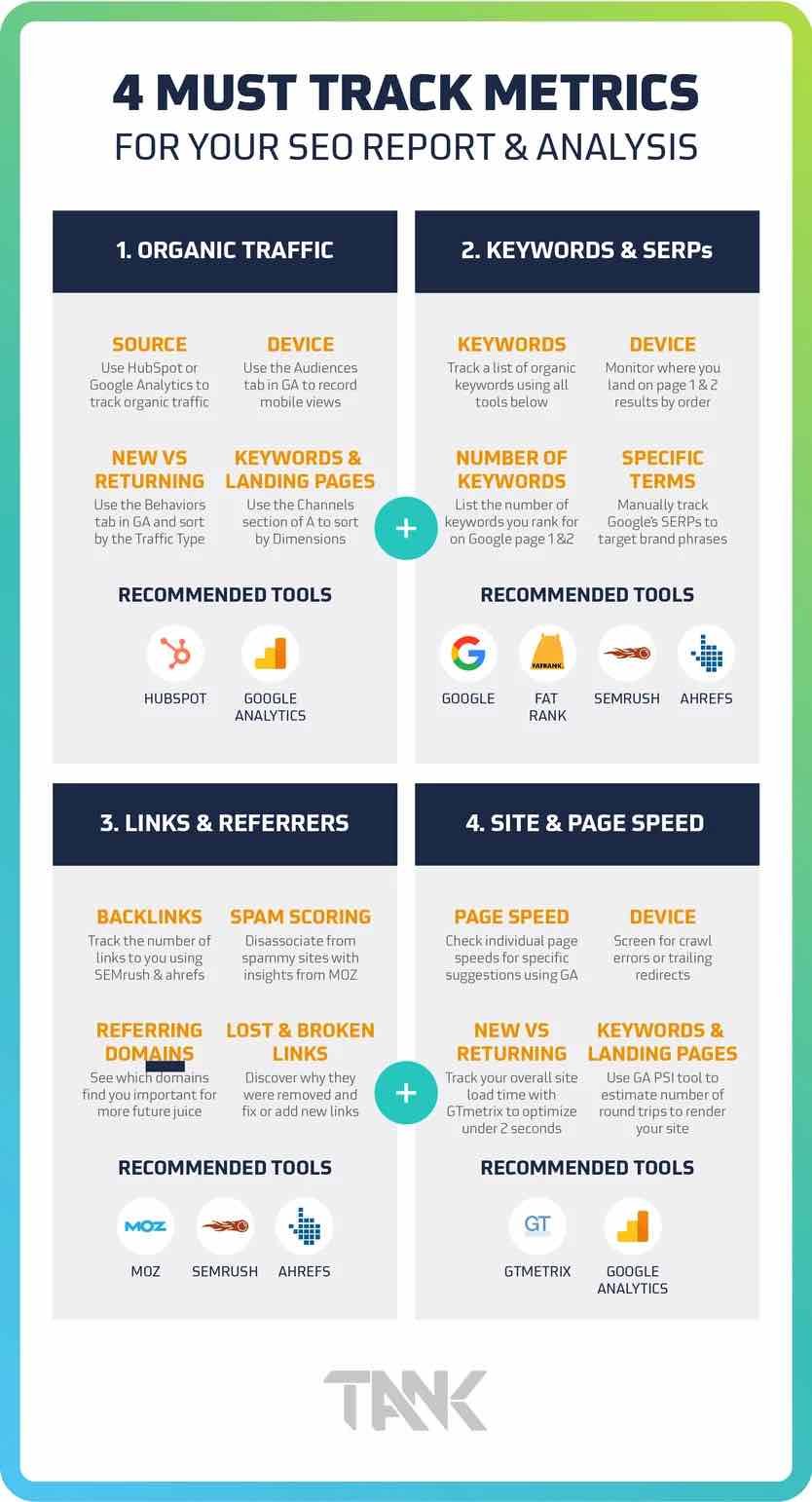How to Pull Together Metrics for Your Monthly SEO Report & Analysis
 TANK New Media
|
TANK New Media
|

SEO REPORTING IS ONLY DIFFICULT BECAUSE PEOPLE AREN'T SURE WHAT METRICS TO MONITOR AND CONSISTENTLY TRACK.
As an SEO or savvy digital marketer, it's super easy to spend hours and hours optimizing your website without any idea of your true impact and the results of your work.
Google and other search engines can take days and sometimes weeks to crawl your updates. Certain SEO practices like link building can generate small wins, but they don't really show results in just one instance. Often it takes an army or many stacked marketing strategies to start notching your way up the search engine results pages (SERPs).
Of course, doing work without a reward doesn't fly for most people. They want to see results — as they should.
However, it's a common thought that SEO is hard to track.
But shockingly, SEO IS NOT HARD TO TRACK!
That is, it's not hard to collect data and present an informative SEO report at the end of each month. What stops people from measuring the success of their SEO is a lack of awareness of how to properly track and monitor it or a lack of desire to keep up with it.
Seeing as you're reading this post, you've already got the spunk — you just need the funk. That is, you have an interest in learning, so now you just need some direction on how to start.
These metrics should be a part of your SEO tracking routine and play an integral role in your monthly reporting analysis.

1. ANALYZE YOUR ORGANIC TRAFFIC
Organic traffic means that users are finding you through the search engine results pages. It's the bees knees of traffic sources.
You need to be aware of where you're getting your traffic from to make educated decisions on how to increase it.
There are many platforms that can tell you where you're getting views. At TANK, we like to use HubSpot in conjunction with Google Analytics.
HubSpot for Traffic Tracking & Reporting
HubSpot will track your various sessions, including your organic traffic, referrals, visits from social media, email marketing, and more.
With the help of their Analytics Tools, we can see that our 2018 organic traffic has significantly increased since we refined our SEO strategy and overall marketing efforts mid-year. Their tools allows us to see which leads were generated from organic search. For us, HubSpot's SEO report shows that our efforts are paying off.
Google Analytics for Traffic Tracking & Reporting
Google Analytics is your friend. There are so many ways to leverage this SEO tool for your website.
Under their Acquisitions section, there are a few ways to use the traffic monitoring data to make search engine optimization driven decisions.
Let's take a look at some of these features.
Source/Medium
Perhaps the most important section for SEO here is the Sources/Medium section which exposes your organic traffic.
In this section we can see that in 2018, only 17% of our traffic came from Google searches. This might urge us to focus on developing more SEO strategies to drive more viewers from the SERPs to our site. We can also use this data to make comparisons of our progress to date. We can see that in 2015 we were only getting 8% of our traffic from Google inquiries and how we've improved from when we first began.
Monitoring your SEO on a monthly basis allows you the opportunity to make quick changes based on feedback. For this month in January of 2019, we have almost 30% of our traffic coming from organic sources. What we've been doing this month is working. This gives us actionable steps to keep the momentum rolling by documenting the changes we've made and leveraging them moving forward.
Keyword & Landing Page Dimensions
Under the Channels section, you can also sort by various dimensions, like keywords, to see which phrases and terms brought people to your site. We'll touch more upon keyword tracking below.
In addition to this, you can check on your traffic by Landing Page. This will show you the most popular pages that visitors are visiting to discover which pages you should vamp up.
New vs. Returning Visitors Traffic
Are visitors who found you already coming back to you organically?
Under the Behavior tab you can check out New vs Returning visitors and add a secondary dimension of Traffic Type to see who was a brand new visitor from organic search and who returned back to you more than one through an organic query.
This is especially helpful to see if you are delighting customers, in that they are returning to you for more and finding you in multiple ways for possibly multiple solutions to their questions.
Device Type
Same goes for device tracking — under Audience, click Mobile to see if more of your organic traffic is coming from mobile or desktop devices and use that data to ensure your pages are AMP friendly or customize the user experience around the devices used by the highest visitor volume.
Keeping up with how you're performing each month is beneficial because you collect data ranges over time, but still can make consistent, quick changes as you catch things. Waiting to do quarterly reports allows a lot of time for things to go array, but with a monthly observation, you can make fast improvements and stay on top of the results to adjust your marketing strategies as needed.
2. TRACK YOUR KEYWORD & SERP RANKINGS
How are you with spreadsheets? If you're an SEO, the right answer should be that you Excel at it.
Was that a Microsoft Office pun? Word.
Actually, we use Google Sheets, but either one of these spreadsheet platforms should be your best bud.
You're going to want to pull data from various tools and search engines and plop them in your sheets to monitor what keywords you're ranking for and the positions your site is being served in on the SERPs.
Why does this matter? Well, knowledge is power.
If you can see, for example, that you're ranking on page two for a certain keyword phrase, you can invest time in targeting material around this subject, giving it lots of love and shares, and crossing your fingers that you might bump to page one and start getting fresh organic traffic to your site.
Tracking your various ranking positions gives you insight on what you're currently be served up for and what you're not, so that you can refine your content optimization and blogging strategies to climb the SERPs.
Let's take a look at two pivotal tools and dive into manual tracking as well to keep up with your positioning.
SEMRush & FATRANK for Keyword Analytics
SEMrush has free features, but a lot of the bells and whistles are featured on the paid version of their SEO tool.
Under their Domain Analysis, they have an Organic Research section with subsets of breakdowns on monitoring your positions on the SERPs, how much volume your ranking keywords get, the cost-per-click for paid ads, and more.
It's easy to export reports and start customizing a Keyword & SERP Tracking spreadsheet to impress your boss.
One of my favorite SEO tracking tools as well is FATRANK's Rank Checker Chrome extension. This is a handy gadget when you're looking for specific keywords and phrases.
Say your boss asks you, "Are we ranking for the keywords around the marketing and sales process? I really think we could be leveraging content around this." You can simply go to your website in the browser and click on the yellow silhouetted cat extension symbol and a text box will appear. Here you can type a keyword phrase like "coolest place in Kansas" and — boom — you'll see the results.
Ahref's Positions Explorer is also a great tool for checking out new organic keywords, but is limiting on what free users can see.
For some more refined location-based SERP tracking, I'll often go right to the results pages themselves for this.
If you use Incognito mode on your browser and search for your desired keywords, slap the phrase &near=your zip code at the end of the URL, but using your ZIP code, to be able to see what searchers in the area are served when they hit the return button for that query.
I like to track keyword rankings and SERPs weekly, so by the end of each month, I have four sets of data points to reference and compile within our handy dandy Google Sheets file.
3. BUILD YOUR LINKS/REFERRING DOMAINS & DISASSOCIATE SPAMMY SITES
Your monthly SEO analysis seriously needs to include some link building strategy and awareness of your referrers.
It's useful to track who's giving you a shoutout and know how much link juice your site boasts to increase your domain authority.
Google and other search engines look for cues from other valid sources in your industry that you're in the game, and if others with good rankings refer you, it only helps boost your relevancy and pertinence to the subject at hand.
In that same regard, if "spammy" sites, often website's that break search engine guidelines, are vouching for you, it's almost like having the bad guy say you're cool. That can send red flags to the search engines — because they're associating you with rule-breakers.
We want to make sure that you're disassociating these links on spam-riddled websites by reporting them to the webmasters. We'll show you how to detect and remove them below.
For tracking links, I turn to three different SEO tools: SEMrush, Ahrefs, and Moz.
SEMrush & Ahrefs for Link Tracking
SEMrush's Domain Analytics features a Backlinks functionality which shows your total number of backlinks, who's referring to you by domain and IP address, what anchor text they're linking off of, your competitors links, and more.
It's a best practice to track these total backlinks and referring domains often, so we record them once a week. Like any paid SEO tools we use, we can export reports for quick copy-and-paste convenience to add to our tracking spreadsheet.
Some people might even go as far as tracking the top-level domain names (TLDs) such as if the referring domain is from .com, .gov, .edu, .org, etc. websites. Google and other search engines smile on a variety of references, so perhaps you can send content to different TLDs to see if they love your stuff enough to link to it.
You should also inspect which links you've lost to try and get down to the why. This is where we tend to shift to Ahref's Site Explorer tool.
This is also a paid service, but they will usually show you a certain number of results on the free version; paid subscribers get access to all data.
Under their Backlink Profile you can check for New, Lost or Broken links and domains. Here you can sort by the last 7 days, 30 days, or 60 days.
This is useful way to see if your links were broken by 404 errors or if someone simply removed your mention all together.
Being able to see the anchor and backlink, where it lived, and when it broke or disappeared gives you the knowledge to reach out to fix it or offer up new content.
Moz for Spam Scoring
If you're an SEO and don't follow Moz, you seriously need to get yourself together.
Kidding. But not really.
Moz features a lot of free SEO tools, but for the Pro paid members, their Open Site Explorer which offers a Spam Analysis.
They use 17 key indicators to mark websites as "spammy" on various scoring metrics. They'll list off the domains that link to you and give them a green to red level of concern.
Oftentimes, some of the sites in green are nothing to worry about, but it's nice to look into why they are graded for possible scam and be mindful of who is reaching out to you.
If you have sites with high spam indicators linking to you, you can report them to the webmasters. Moz actually provides a useful article on how to disavow links properly if this is something you need to do to clean up your linking presence.
Understanding who is linking to you and what they are pointing to will give you helpful insights into what content people find most attractive. With this knowledge, you can leverage more content around these topics by developing a link building strategy.
For more consistent SEO efforts, you could also track the number of citations and reviews you have and share your NAP (name, address, phone number) on more websites or display your review ratings online.
4. INVESTIGATE WHAT'S SLOWING YOUR SITE SPEED
You might be wondering how website load speed affects your SEO. The answer is: it affects the user experience (UX) which matters for bounce rate, and as a result, relevancy in the SERPs.
Let us explain what this means.
Google announced in 2010 that they were going to start regarding website load speed as a ranking signal. Back then they originally stated,
“While site speed is a new signal, it doesn’t carry as much weight as the relevance of a page. Currently, fewer than 1% of search queries are affected by the site speed signal in our implementation.”
Over the last few years, Google's been announcing consistent "Speed Updates" about how it factors into their ranking factors. On Google's blog, they released this statement early 2018,
"The “Speed Update,” as we’re calling it, will only affect pages that deliver the slowest experience to users and will only affect a small percentage of queries."
If it's only affecting a "small percentage of queries," should you be concerned? Here's why speed still matters for SEO.
Although only a small number of queries are chastised right out of the gate by Google for slow load speeds, users don't stay on slow sites. And if users don't stay on slow sites and bounce back to the SERPs for their answer after a few seconds of frustrating load time, that sends a signal to Google that that site did not answer the searcher's question. Hence, in the eyes of their algorithm, you aren't relevant for the user's search terms; and if you're not delighting searchers, you're pushed down.
So, does Google's algorithm directly penalize you for a slow website by not serving you in the SERPs? A little bit.
Do users penalize you for a slow website? Absolutely, and their actions dictate Google's reactions.
To stay on top of your UX to engage your users, review these stats each month to make informed decisions concerning improving your page speed.
Google Analytics for Site Speed Suggestions
We're back to our go-to, Google Analytics. Under their Behaviors drop-down, you'll discover a section for Site Speed. Here there's a subset for Speed Suggestions.
This will give you data on your individual average page load times to see which pages are running the slowest.
The goal should always be to load in 2 seconds or less (although this number is ambiguous, it is generally accepted as a goal for SEOs), so if you aren't hitting that mark, you can click on their PageSpeed Suggestions for an analysis of specific things that are slowing down you load speeds. This exposes your problems and makes you aware of what you could optimize.
In fact, Google offers a PageSpeed Insights crawler, much like the suggestions you'd find within your Google Analytics for people without an account. This PSI, as they call it, will tell you how many "round trips" the crawler took to load render blocking resources and how many megabytes (MB) it took to fully render your site.
They share that the median page number for round trips is 4 times and 2.7 MB, but obviously fewer round trips and bytes result in quicker loading pages and more streamline performance.
Check out what rules Google's developers recommend for site speed optimization.
GTmetrix for Site Speed Suggestions
You can also use GTmetrix to run a detailed report on what is slowing your site down. You'll get a breakdown of your page speed and your overall load time and can download a PDF of detailed steps to make improvements.
What's cooler — is this is a free SEO tool.
The scan will serve you an overall, big picture outline of your problems, whereas Google Analytics can break things down on a page level.
NOT SURE WHERE TO START? TRY RUNNING A PERSONALIZED SEO AUDIT ON YOUR WEBSITE.
Although the steps are laid out for you, it might seem daunting to start a formal SEO tracking routine. Maybe you're looking for a way to begin or insight into your optimization issues. Or perhaps you want a digital marketing company to do the heavy lifting for you. If so, read about our digital marketing services then give us a shout. Together we can improve your organic reach.
This post was written by Jenn, SEO Strategist, and originally appeared on invoqmarketing.com.
Subscribe to Our Blog
Stay up to date with the latest marketing, sales, and service tips.


